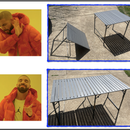Introduction: Using Tinkercad Models to Represent Sizes and Distances in Space (Scene Category)
Astronomy teachers often use physical scale models to help students wrap their minds around the distances to and sizes of objects in space. Examples of these include "solar system walks" to lay out the distances to the planets and building models out of clay to represent their sizes.
In this Instructable I will outline a procedure for creating scale models for Astronomy instruction using Tinkercad.
- the first model focuses on sizes in the Solar System
- the second on distances in the Solar System
- and the third on the distances to stars.
Each step will include images showing models I made while following these procedures. I will also provide a document that can be used by students that doesn't have these "answers".
I think, given our current concerns with disease transmission through shared supplies and the strong possibility of students eLearning from home this fall, there is a real benefit to developing these types of "virtual hands-on" activities with resources like Tinkercad.
Supplies
- device with Tinkercad
Step 1: Size Scales in the Solar System
- In Tinkercad, click on "Edit Grid" in the lower right hand corner, then resize the grid to a length and width of 500 mm.
- Add three spheres to the grid. Color code them as follows:
BLUE = Earth GRAY = the Moon ORANGE = Jupiter - Use google or another resource to find the diameters of these three astronomical objects in kilometers.
- The scale for our model will be: 1 mm in Tinkercad = 1000 kilometers in Real Life
- Resize the spheres to create scale models of the three objects. NOTE: In Tinkercad you change the diameter of a sphere by changing its Length, Width, and Height.
- Arrange your planets so that none of them overlap (I also decided to raise them vertically) and use the "Text" tool in "Basic Shapes" to add labels and a scale.
TEACHER NOTE ... To save you a little time, here are the diameters of the planets and scaled sizes of the spheres:
- Earth diameter = 12,742 km = 12.742 mm on Tinkercad
- Moon diameter = 3,474 km = 3.474 mm on Tinkercad
- Jupiter diameter = 139,820 km = 139.820 mm on Tinkercad
Step 2: Distance Scales in the Solar System
Now that we've got scale models of the Earth, Moon, and Jupiter, we'll build a model that helps you understand distance scales in the solar system.
- You might need to drag some of the text labels out of the way before you start just to clear up your Workplace.
- Click on the Ruler tool and place the origin somewhere along the left side of the Workplane.
- Drag the Earth so that it is positioned over the origin. It's vertical height doesn't really matter.
Use google or another resource to find the Earth-Moon distance in kilometers.
Drag the Moon to that it is the correct scaled distance from the Earth - the ruler tool will display the distance between the Earth and Moon spheres. Use the same scale (1 mm = 1000 kilometers).
- Drag the labels back in to their correct places.
Step 3: Discussion Questions & Extensions
Here are some suggested questions or extensions you can use after your students have created and shared their models. You can test their answers to the questions by copying and pasting the objects that are in their models.
Questions...
- The diameter of Jupiter is equivalent to how many Earths?
- How many Earth's would fit inside Jupiter?
- How many Jupiters could fit between the Earth and the Moon?
Extensions...
- Add the Sun to your scale model. NOTE - The Sun's diameter is 1,392,700 km in real life so it will be 1,392.7 mm in Tinkercad. This is much larger than the planets and moons so it will not fit on the Workplane. It is a cool way to get a sense of it size though. See the image above.
- Add other planets and/or their moons
- Research planets that have been found orbiting other stars in the galaxy, make scale models of these to compare them to the size of the Earth
Step 4: Constellations and Distances to the Stars
Generally, students knowledge about stars when they enter an Introductory Astronomy class is limited the names of some constellations and an awareness that stars are very far away.
In this activity we'll build upon this knowledge by creating models of constellations that include a scale representations of the distances to the stars that make them up.
- Start with the standard Tinkercad workspace. Add one star and make it's length and width 10 mm (a bit larger or smaller is fine).
- Use google or another resource to find a picture of the constellation you'd like to model. For my example I've used the Big Dipper (which is technically not a constellation, but let's just go with it)
- Make enough copies of your star in Tinkercad and arrange these to recreate the constellation. NOTE - If you've chosen a complicated constellation only include the major stars (enough to get the general shape of the constellation)
- Now do some additional research to determine the distances from the Earth to the stars in this constellation.
- To scale the distances, we're going to use the "floor" of the Workplane as the surface of the Earth and move the stars in your constellation to a height that corresponds to their distance from Earth. For the Big Dipper a scale of 1 mm = 1 lightyear works well, but for constellations with a greater range of distances you might try 1 mm = 2 ly or more.
- With the stars at the correct distances, the shadow on the Workplane shows the appearance of the constellation from the Earth's surface. The view can be rotated to see how different perspectives make the arrangement of the stars look very different.
Step 5: Second Example of Distances to Stars - the Constellation Orion
The images above are included as a second example of the activity in the previous step.
Note that there is a much greater range in the distances from Earth to these stars to a scale of 1mm = 2 ly was used.
Also, Orion consists of many more stars than the Big Dipper so only enough stars to represent the general shape of the constellation were included.
Step 6: Examples of Student Work
The images above are examples of work students have done on these projects.
- Here are links to their creations on Tinkercad (In order to avoid posting student contact information publicly I copied their work into my Tinkecad account)
Step 7: Student Worksheet
I hope you've found this Instructable helpful. Here is a guide students can use to work through the steps.
If you have any questions or suggestions, please let me know
Thanks!

Runner Up in the
Distance Learning with Tinkercad Contest












